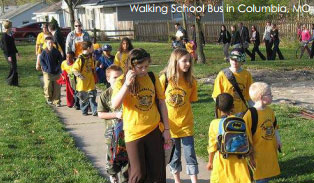Develop Safe Routes to School or a Walking School Bus
Safe Routes to School is a national and international movement to create safe, convenient, and fun opportunities for children to bicycle and walk to and from school.
Description

Safe Routes to School is a national and international movement to create safe, convenient, and fun opportunities for children to bicycle and walk to and from school. Funding is available to cities and school districts for infrastructure projects like sidewalk construction, as well as educational and encouragement programs. The program has been designed to reverse the decline in children walking and bicycling to schools. Safe Routes to School can also play a critical role in reversing the alarming nationwide trend toward childhood obesity and inactivity.
Related Tools
When paired with other tools, safe routes to school can contribute to a healthier, more active, more participatory, and more sustainable neighborhood. Think about community cohesion, public art, local prosperity, public safety, and healthy vibrant communities. Try combining this with strategies such as:
Community Projects
Add your project
Neighborhood Benefits
Environmental
- Increased transportation choices that improve personal health and reduce waste, energy consumption, and pollution associated with car travel
Social
- Improved safety for children's commutes to school
- Healthier and more equitable modes of transportation
- Stronger neighborhood relationships between both children and parents
Economic
- Reduced cost of transportation for parents
- Increased walkability for more foot traffic to local businesses
Get Started
- Contact Contact the principal of your child's school to inform them of your interest in having a walking or biking event. Work with them throughout the process to ensure proper scheduling, volunteers, and support for teachers.
- Connect Trailnet is dedicated to promoting walking and biking in St. Louis. Their Safe Routes to School programs and events educate teachers, parents, and children and get them all engaged in healthy and active lifestyles. They offer organizational support for your events, so contact them to learn more about programming.
- Organize Supervisors Walking school buses or bike trains are usually a group of kids that go to school with at least one adult supervisor along a safe route. Trailnet events usually include an educational component for kids, many parents, teachers, volunteers, name tags, and refreshments.
- Plan Long Term One time events are fun and educational, but for many communities, one event is not enough to change the daily routine of parents and kids. During your Walk to School Event, talk with parents and teachers to get contact information from those that are interested in starting a regular Walking School Bus or Bike Train. Plan to contact them soon after to organize a regular schedule and work out more details.
- Schedule Meet with interested parents to see who is available to lead the kids group on which days of the week. Organize a schedule and test your plan for one month. Assess if there are any changes that need to be made or if anything can be improved. Keep in contact with your school to update them on your progress. Special incentives like mileage tracking and bike clinics are important to keep parents and kids excited. More information about how to create an ongoing walk or bike to school programs can be found at walkbiketoschool.org.
- Combine Forces If not all children are within walking distance, consider a compromise by combining a Walking School Bus with a carpool.
- Create a Project The Missouri Department of Transportation is a member of the national Safe Routes to School Organization, so they often have grant funding available to communities for infrastructure improvements such as repairing sidewalks, ensuring ADA accessibility, improving crosswalks and cross signals, and more. More information can also be found through the Missouri Bike Federation. After establishing a route to school, assess the physical environment to see if anything can be done to improve the walking experience, such as improving sidewalks, adding trees, or adding bike lanes. Work with the City Streets Department and the City Forestry Department to request some of the changes. If more funding is needed, work with your neighborhood association to get grants for improving the route.
Opportunities
Related Categories
Sustainability Plan Categories
Project Scale
- Block
- Neighborhood
- Street
Download This Tool
Develop Safe Routes to School or a Walking School Bus Doc (462.10 KB pdf)
Need Help Viewing?
You need a program that can open Adobe PDF files. A free option:
- Adobe Reader can read PDF files